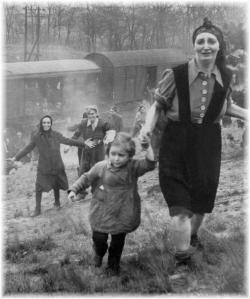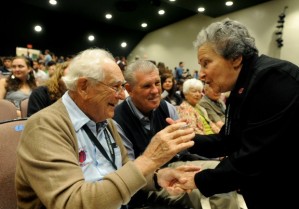Tomorrow is Thanksgiving day. Today I stumbled across a holiday greeting I received from Holocaust survivor Ernest Kan a while back. It was about being thankful, simply appreciating what you have. So it reminded me to share Ern’s story (which I recorded) at a gathering of former American soldiers and Holocaust survivors.
It was Ern’s turn to speak. He came to the front of the room to address “his” soldiers:
My odyssey began in Riga, Latvia where the Germans occupied our apartment on the first of July, 1941. Shortly thereafter we were put into the Riga ghetto. During the partial liquidation of the ghetto on November 30 and Dec 9. 1941, my mother was murdered with 27,000 other Jews in the forest of Rumbula.
The ghetto was finally liquidated in 1943. My dad was shipped to Auschwitz where he perished, and I was put into the concentration camp Kaiserwald near Riga. With the approach of the Soviet army in 1944, Kaiserwald was evacuated by ship and we were shipped to Stutthof concentration camp, after about a month to Polte in Magdeburg where I was liberated.
I was 19 years old at the time of imprisonment, and held captive altogether 44 months.

The main gate through which the prisoners entered the factory every day for shifts of 12-14 hours. Source: Lev Raphael, Polte-Fabrik slave labor camp, http://www.levraphael.com/sg_poltefabrik.html.
The name of the factory was Polte; it was the largest ammunition factory in Germany. Conditions were very bad. They had 30,000 slaves working there in shifts. It manufactured heavy artillery shells, big coastal artillery shells about 30 inches long. And we had to work in 12 hour shifts.
They brought us there from a concentration camp Stutthof, near Danzig, by freight train, it took about two nights, and we got there we didn’t know where we wound up, we were assigned to bunks in a barracks, and it was about a mile to walk from the factory and back.
And that is where I was liberated in April 1945 by the 743rd US Tank Battalion, the 30th Infantry Division.
After an air raid by the United States [Army] Air Force, the camp was evacuated and they marched us southward, because the south was still unoccupied by Allied forces. So they assembled the prisoners and marched them out of the camp, and we had to move a large wagon with spoke wheels, they had no more horses to pull the wagon, we were pulling and shoving the wagon with all the luggage and personal belongings of the guards.
So as when we passed that factory, Polte, me and three other guys, we ran into the open gate, the factory was already disabled-there was no more electricity, no water, no nothing, it couldn’t function anymore- it had been made unoperational by air raids. So we ran and we hid, we changed our striped uniforms and we put on German overalls we found in a locker so we looked more or less human again, but we had no hair, the hair was shaved off.
And we hid in an attic above the office …we stayed there one night, and in the morning four SS guards with drawn guns found us and said “Out you swines, hands up!” and marched us to the courtyard of the Polte factory, they had about 100 or so lined up with their hands up, and they came with little lorries, little trucks, that took groups of 10 away and returned within five to eight minutes empty for the next batch-so we knew they took them to the forest to shoot them and come for the next.
And I thought that was the end of us, I was standing with my hands up and I said to the guy to my left, “this is it, we made it up until now” -and lo and behold, an air raid started! The United States [Army] Air Force, low flying bombers came, you could see the pilot’s eyes -that’s how low- they dropped the bomb load, [the guards] chased us in the adjacent air raid shelter, all the guys were at the wall in the air raid, they posted a guard in front of that door and as we walked in he said “I’m innocent, I never did you any harm.” He was an old, old man, older than me today. So when I heard that, there was already music in my ears all of a sudden, I had never heard that from any guard to say something like that.
So they locked the door and put a padlock on the outside. And you could hear the bombs falling and the smoke seeping through and it was chaos, we were singing inside and we were happy, praying the bombs should hit us and get us out of our misery, because by that point we were finished.
So I leaned against the door and the door gives, so I don’t know to this very day whether the air pressure from falling bombs blew the lock off, it was a big padlock, or if the guard posted outside opened it up and took it away. At any rate the door was open, we all ran out scattered left, right and the four of us hid in an elevator shaft up above where the wheel is, and we waited until the air raid stopped and after about an hour we sent one guy out to reconnoiter what was happening, it was dead quiet. We didn’t know who was where and what was going on. So after about half an hour he came back with a big vat of soup, and he said [Ern stops-long pause. He composes himself, and speaks slowly]:
“Boys-we are free-the Americans are here!”
That is a moment I can never forget.
The soup was lentil soup, it was delicious, I ate and ate until I threw up-we hadn’t eaten in so many days, and I then I saw the first American in a Jeep.
I had never seen an American, he looked like a Martian to me with different weaponry and a Jeep. And he says to me, “Hands up! You are German?” I said, “No, I am a Jewish prisoner from the local concentration camp” but by my haggard appearance he could see that I was certainly not an enemy. I was about 75 pounds at that point and it so happened that when I found the overalls in the German locker, I put on a belt I found there and it had a swastika locket which I didn’t realize, I put on the belt not to lose my pants and he saw the swastika on it and he assumed I was a German in overalls, so I told him I was from the local camp.
It so happened that he was a Jewish GI and he embraced me and he said “You are free now, you can go wherever you want” and he gave me a an army issued prayer book, and a mezuzah, that is something like sort of an amulet that some people wear, it contains some proverbs from the Deuteronomy inside, and he said “Go!”
In the heat of the moment I was unable to ask him where he came from, what his name was, and it bothers to this day that I could never express my gratitude to this one man, but all these guys here are my liberators and they represent this first American I ever saw and he gave us back our life and our freedom and I will never forget it.
There are no words to express my gratitude for what they have done for us and never in my vaguest dreams would I have thought to be here 65 years after the war is over and meet these guys again, that is unbelievable, it is a moment, an unforgettable moment in my life.
RECORDED IN MARCH 2008.





